On View
A New Survey of Pierre Cardin’s Futuristic Fashions at the Brooklyn Museum Examines the Designer as a Pioneer of Modern-Day Branding
Cardin worked to embrace “lifestyle” before it was articulated as such.
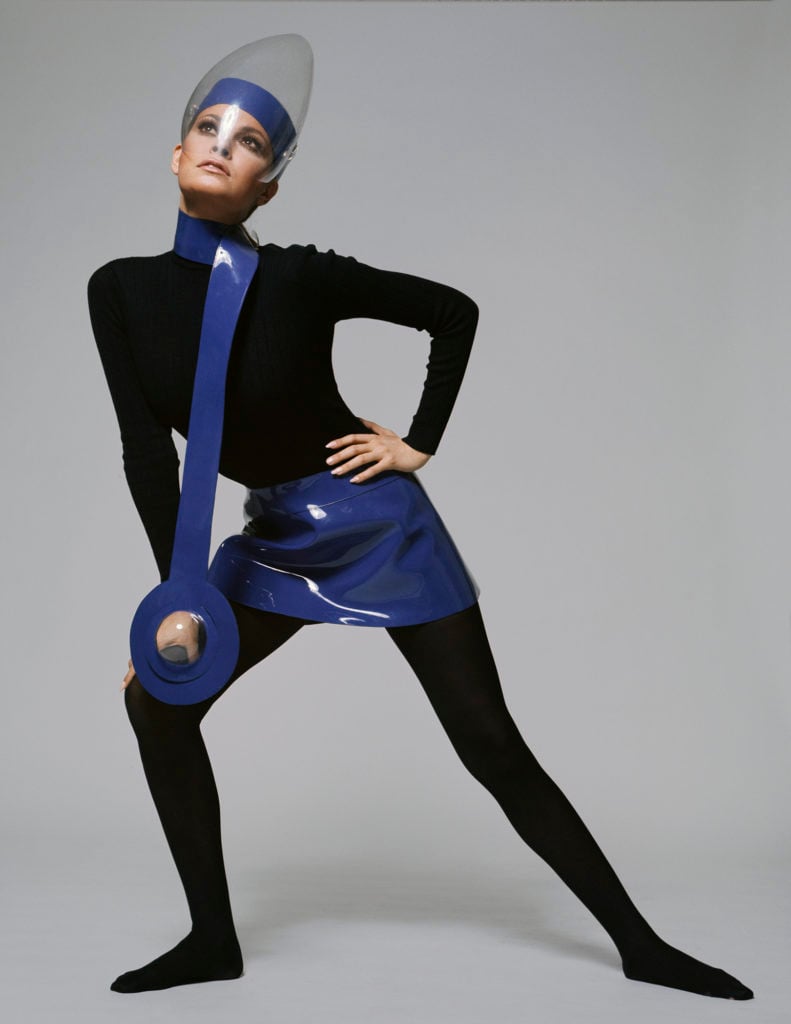
Cardin worked to embrace “lifestyle” before it was articulated as such.

Colleen Kelsey

The French fashion designer Pierre Cardin, like much of the world in the 1960s, was fixated on far-off horizons—and not just on Earth. He was looking at the possibility of new worlds, and how we would dress for them.
The couturier, now 97, spent much of the decade forging an aesthetic that focused on youth-fueled modernism, veering away from the previously studied decorum of the atelier. That meant developing the streamlined, future-focused vernacular that would come to define his work: sculptural and kinetic geometric, cylindrical, and lenticular silhouettes, fabricated from innovative technology and unusual materials. Like his “Space Age” design contemporaries of the era, Paco Rabanne and André Courrèges, Cardin perfected using and manipulating fresh-to-market synthetics, plastics, and vinyl, even molding Plexiglass into bandeaus and egg-shaped headgear. They were garments that projected utility but were irresistibly sleek and sexily alienish; clinically pristine, yet sinuous—all the appeal of an Eero Saarinen Tulip chair, but made for the body.
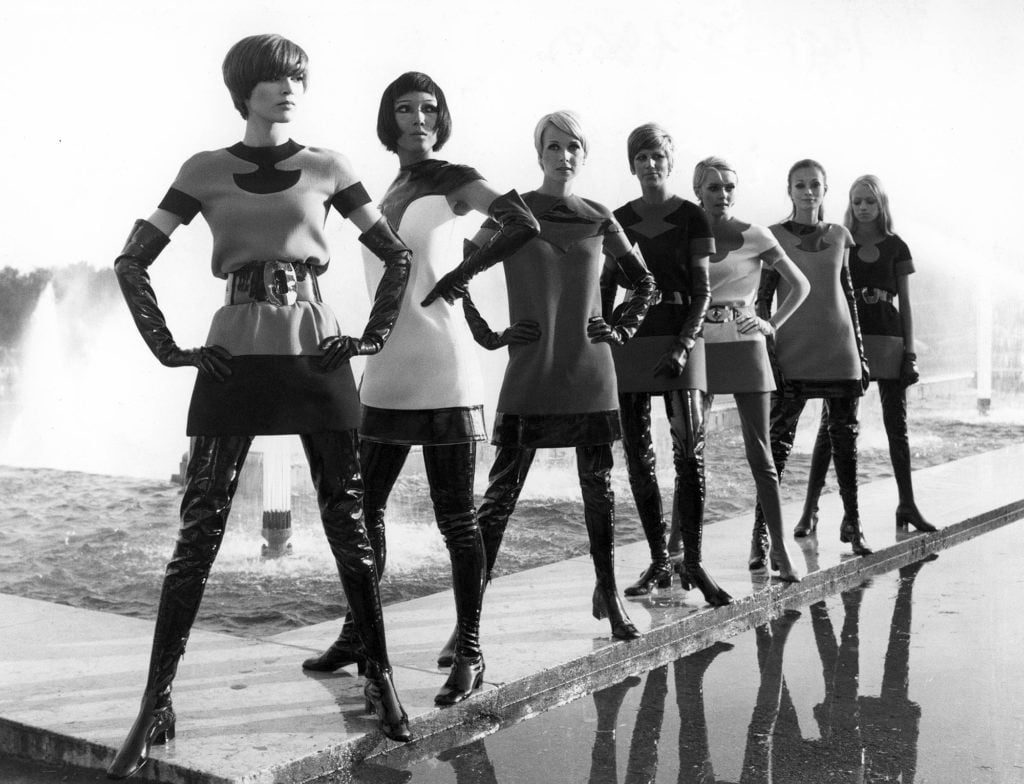
Pierre Cardin’s two-tone jersey dresses with vinyl waders, 1969. Photo courtesy Yoshi Takata. © Pierre Pelegry.
Tomorrow is the fiftieth anniversary of the Apollo 11 mission touching down on the moon, and the Brooklyn Museum will open Pierre Cardin: Future Fashion, a new retrospective of Cardin’s work. With over 170 objects on view in the museum’s fifth floor galleries, it’s the most comprehensive Cardin retrospective since the one Diana Vreeland mounted at the Met in 1980.
Curator Matthew Yokobosky describes feeling the pull of the ‘60s in contemporary collections. “Over the past five, ten years, people have been looking back at the ‘60s,” he says. “And Pierre Cardin was popping out as someone doing incredible things in the ‘60s.” Cardin resurfaced more clearly for Yokobosky during the museum’s 2013 Jean Paul Gaultier retrospective, after he saw a video from 1972 of the young Gaultier assisting in Cardin’s atelier.
“The clothes continued, but he diversified a lot away from fashion,” Yokobosky says of Cardin’s career, which moved quickly into disciplines outside of couture. He worked closely with Cardin and his archive to pull key looks, accessories, furniture pieces, sketches, news films, and other ephemera to build out, according to Yokobosky, “the Cardin world.”
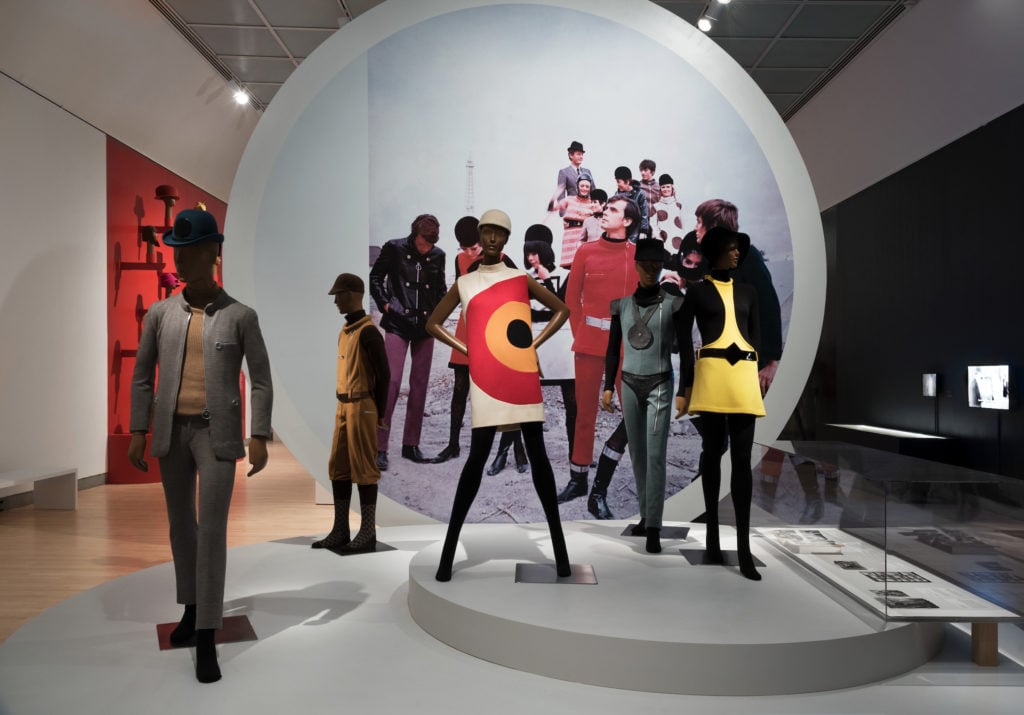
Installation view, Pierre Cardin: Future Fashion, Brooklyn Museum. Photo courtesy Jonathan Dorado, Brooklyn Museum.
Organized chronologically, the exhibition makes note of Cardin’s involvement in pivotal moments of twentieth century fashion, from assisting with the design of costumes and masks on Jean Cocteau’s La Belle et La Bete (1946); working at Schiaparelli and Dior, when the house debuted the Bar jacket; dressing Jackie Kennedy; teaching at Bunka Fashion College in Tokyo (where Kenzo Takada was a student), and employing Gaultier (who would later take on Martin Margiela as an apprentice). Recurring visual motifs—like Cardin’s use of circles, exaggerated shoulders, gender-neutral garments, and spherical helmet-like headpieces—are siloed into their own capsule moments throughout the space.
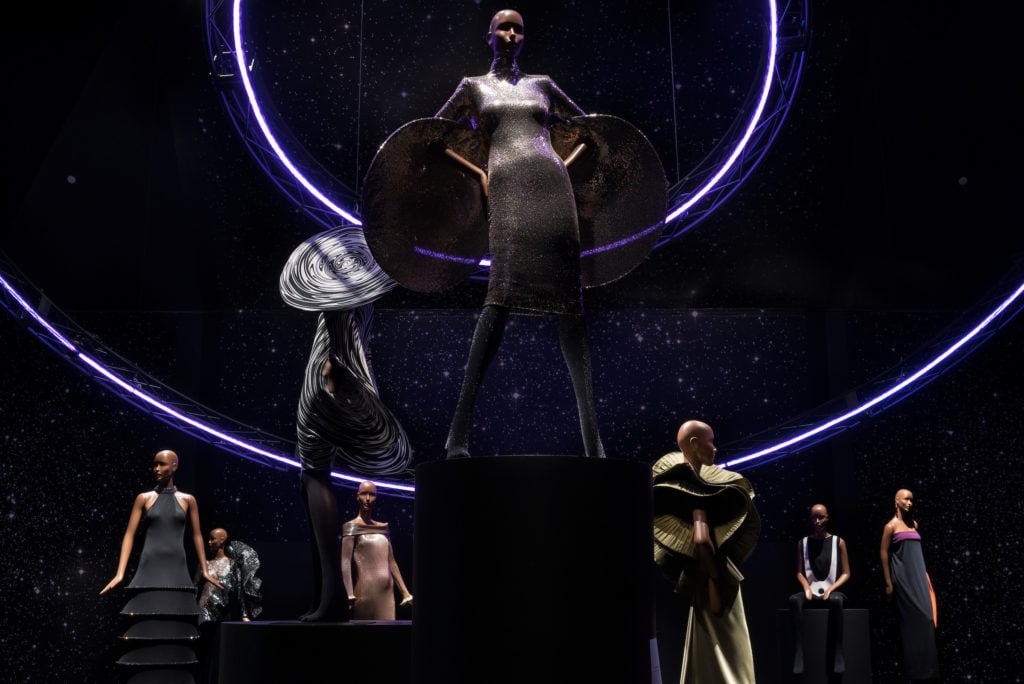
Installation view, Pierre Cardin: Future Fashion, Brooklyn Museum. Photo courtesy Jonathan Dorado, Brooklyn Museum.
The exhibition continually returns to a narrative on innovation and the streak of populism that shaped Cardin’s business approach. Crucial moments—like Cardin’s status as the first couturier to launch ready-to-wear in 1959 with the department store Printemps (and which got him temporarily thrown out of the Chambre Syndicale de la Haute Couture, the French organization that formally determines which fashion houses are considered true haute couture houses)—speak to his interest in democratizing high fashion and his embrace of uncharted frontiers. (Other designers, like Yves Saint Laurent, who rolled out his Rive Gauche prêt-à-porter line in 1966, would follow his lead.) The same could be said for Cardin’s embrace of licensing his name in the ‘70s and ‘80s, which gave rise to Cardin fragrances and a score of other more comfortably affordable wearables, plus his other aesthetic pursuits—including furniture, industrial design, and his acquisition of the Parisian restaurant Maxim’s, the historic Théâtre des Ambassadeurs (converted into the Espace Pierre Cardin, a cultural center), and the Palais Bulles, or “Bubble Palace”, the famed architectural landmark in the south of France.
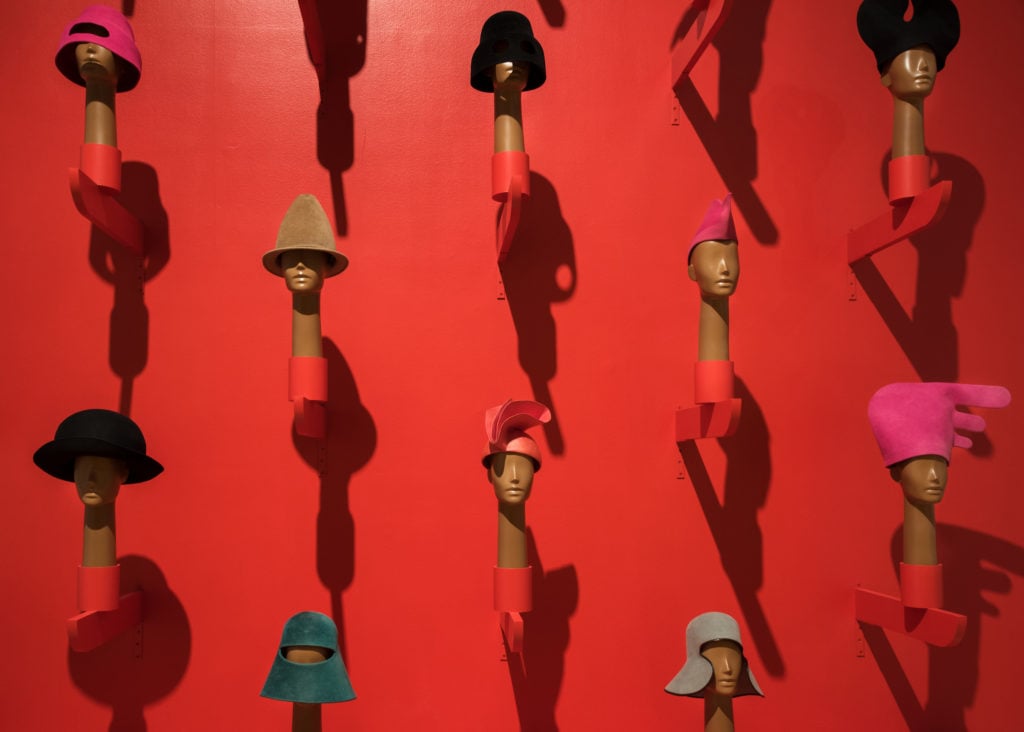
Installation view, Pierre Cardin: Future Fashion, Brooklyn Museum. Photo courtesy Jonathan Dorado, Brooklyn Museum.
But what comes across clearest, aside from the collective sprawl of Cardin’s life work, is his position as a forward-minded polymath pioneering the business of branding before every luxury label was offering fully branded aesthetic ecosystems, “curated experiences,” and meme-able items designed to thrive on the reseller market. Cardin worked to embrace “lifestyle” before it was articulated as such. Before Armani and Versace made homewares, Chanel tricked out a surfboard, and Isabel Marant emblazoned her logo on a kitchen sponge, Cardin proposed wearing Cardin clothes, Cardin shoes, sitting on a Cardin sofa under a Cardin light fixture wearing Cardin a fragrance, eating in a Cardin restaurant, and driving a car with a Cardin interior.
In 2019, it’s ubiquitous for the designer to serve more holistically as a creative director and arbiter of taste. It’s something Cardin’s legacy personifies even if it wasn’t entirely by design. The houses of Paco Rabanne and Courrèges have had well-received revivals under a new generation of designers adapting their language to the twenty-first century. Louis Vuitton womenswear designer (another fellow futurist) Nicolas Ghesquière, who loves a mid-century retro-future reference, showed his resort collection for Louis Vuitton at the new TWA Hotel in the recently restored Saarinen-designed TWA Flight Center at John F. Kennedy Airport. Off-White helmer and Vuitton menswear designer Virgil Abloh thrives on the collab model. One recent effort is with Swiss furniture company Vitra (which follows projects with Ikea, Takashi Murakami, Nike, Levi’s, and more.) And Cardin, who still retains control of his company without outside financial backers, and goes into the office everyday—he’s still looking forward.
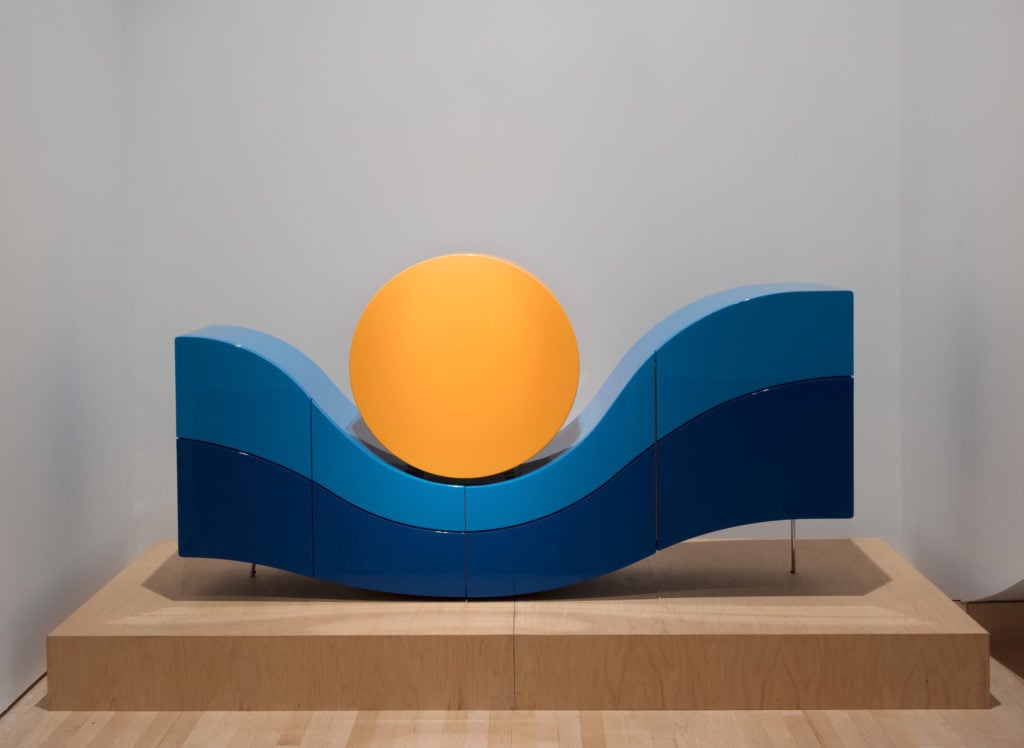
Installation view, Pierre Cardin: Future Fashion, Brooklyn Museum. Photo courtesy Jonathan Dorado, Brooklyn Museum.